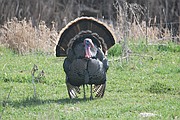It's Thanksgiving ... let's talk turkey!
“Forever on Thanksgiving Day, the heart will find the pathway home”
— Wilbur D. Nesbit
Here’s something to ponder as Thanksgiving approaches: Wild turkeys are found across Idaho, and open hunting season recently ended on them in the North Idaho Panhandle. But they’re not native to the state. Turkeys actually were introduced by Idaho Fish and Game in 1961.
“Turkeys have adapted so well in northern Idaho, they have become a nuisance in some locations,” Idaho Fish and Game reports. “Wild turkey populations in Idaho are largely found in the Panhandle, Clearwater and Southwest regions.”
Boundary County has the luxury of having a good population of wild turkeys. Some people have called them a nuisance, but always welcome on our Thanksgiving dinner table.
Wild turkeys are one of our largest wild birds. They stand 36 to 48 inches tall and can weigh up to 25 pounds. They have long, powerful legs. Their wings seem short for such a large bird, but turkeys can quickly burst into flight. Their quick bursts allow them to glide for up to a mile to get away from danger. Scientists have clocked wild turkeys flying at 60 miles per hour! Because turkeys are heavy they cannot fly far. Instead they rely on their legs to get where they need to go.
Turkeys are brownish over most of their bodies. The males, called toms, have a bronze sheen to their feathers. The wing feathers are barred with black and white. Females, called hens, have a few feathers on their heads, but the toms have no feathers. The skin on the tom’s head and neck is colorful. They have a white forehead and blue face. The neck is red.
In the spring these colors become very bright and are part of the male’s breeding display. Tom turkeys also try to impress the hens by fanning their large tails and drooping their wings. They also gobble. You can hear a gobbling turkey more than one mile away!
Hens lay their eggs in a shallow nest on the ground. The eggs are tan with tiny reddish spots. Hens incubate the eggs for about 27-28 days. Baby turkeys are called poults. Poults are precocial which means the baby chicks are covered with downy feathers when they hatch out of their eggs and can leave the nest soon after hatching.
Many ground nesting birds are precocial. Precocial birds can feed themselves, therefore they do not have to stay in the nest waiting for their mother to bring food. Instead, they follow their mother to good sources of food, water and shelter.
Turkeys can live in many kinds of habitats. You can find turkeys in forested openings, grasslands, and even swamps. Their diet is made up of seeds, nuts, fruits, buds, insects and small animals like frogs, salamanders, and snakes. Family groups of hens and young turkeys spend the day looking for food. At sundown, the flock will fly into large trees where they will roost and rest for the night.
Most of us won’t eat wild turkey for Thanksgiving as the Pilgrims did. We’ll instead carve up farm-raised turkey, derived long ago by turkey farmers, breeding domesticated turkeys and wild turkeys. Whichever is your choice of turkey, wild or domesticated, celebrate Thanksgiving with your family and friends.
Have a good Thanksgiving and I hope a turkey is part of your dinner and family celebration.



